Quality Score Factors
Quality score is an especially important component of your ad rank computation in Google. It shows you an estimate of how relevant your ads, keywords, and landing page are to a person who sees your ad. This score is scaled from 1 to 10, with 1 being the lowest and 10 being the best.
Higher Quality Scores typically lead to lower costs and better ad positions. You can only view your Quality Score at the keyword report.

What influences Quality Score?
Landing Page Experience - Estimates how relevant and useful your landing page is to people who click your ad. It considers factors such as how well your landing page content matches a person’s search term, and how easy it is for people to navigate your page.
Expected CTR – Do not confuse this with your click-through rate. Expected CTR refers to how likely it is that your ad will be clicked when shown. In other words, this is kind of a normalised percentage. This score is based on the past clickthrough performance of your ads. The effects of ad position, and other factors that affect the visibility of your ad, such as extensions are excluded.
Ad Relevance - Measures how closely your keyword matches the message in your ads. A below average score may mean that your ads are too general or specific to answer the user’s query, or that this keyword isn’t relevant to your business.
How to check Quality Score?
Click on ‘Keywords’ then ‘Search Keywords’.
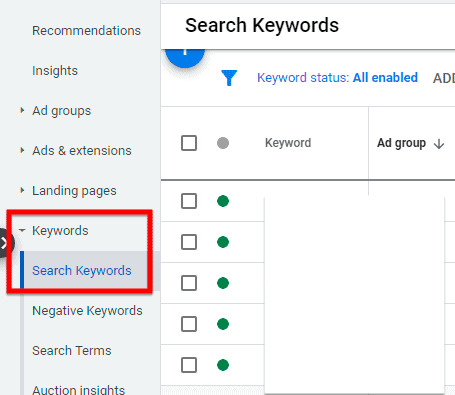
Next, Click ‘COLUMNS’ AND ‘Modify columns’.
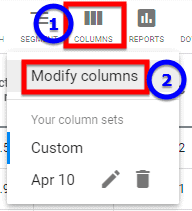
Scroll down and click ‘Quality score’.
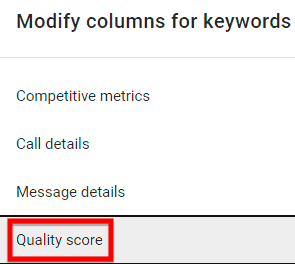
Check the ‘Quality Score’ boxes then click ‘APPLY’.
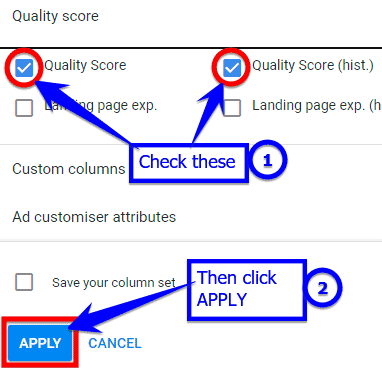
You can now see the Quality Score and historical Quality Score.
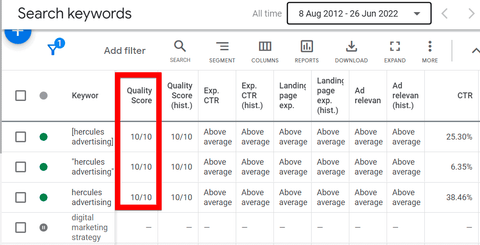
If you examine the factors that contribute to Quality score (Landing Page Experience + Expected CTR + Ad Relevance), they are inter-related. It’s intelligible that with a high ad relevance, it will result in a higher expected CTR. That’s half the battle won; the final part is the landing page experience.
If you have good keywords that are targeted, and you write ads that are relevant, and after the click-through, the landing page has been positive, it will positively affect your Qualify Score. As an analogy, Quality Score is like a reflection of the entire customer journey of a search ads user; whether the user experience has been positive or not.
Optimising Quality Score
Group keywords that trigger the same ad(s) and landing page into the same ad group. This ensures that the ads, landing page and keywords are all closely related which translates to better relevance.
Improve relevance of advertisement to landing page – Example: Ads on “vegetarian catering” should land visitors on the “vegetarian catering” page, instead of “catering” homepage. The landing page should contain specific information on “vegetarian catering”, and do not send them to a generic catering page upon ad click.
Improve landing page’s user-experience – Make your landing page well-organised, include relevant and original content as well as keywords that trigger the ad in the content and make it prominent. Speed also plays a factor here; users hate slow pages and are more likely to abandon them. Not only does a quick loading page improve user experience, but it will also contribute to better conversions. A fast web hosting can help to improve the landing page user experience.
Transparency – Include information about you or your company, along with any related photos of yourself.
Ease of navigation – Include navigational menu to other pages with links or buttons that make the website easy to navigate around. Of course, you can also use a landing page, but make sure it is professional looking with your legal pages linked at the footer of your landing page. That includes your privacy policy, terms of use and contact information.
How can I increase my Quality Score?
Ensure your ad copy includes the keyword you bid for. Identify those ads with low click-through rate (CTR) then rewrite them with more curiosity-invoking and eye-catching headlines. Learn more in PPC Copywriting Tips.
Ensure your landing page is mobile friendly, fast loading, responds quickly to user interaction upon loading and visually stable. Leverage the Google Keyword Planner tool for semantic research to add more semantically related keywords in the landing page.
Organise your keywords and Ad Groups by themes, which will allow your ads, landing page and keywords be highly related and relevant.
What is the minimum Quality Score I need?
A Quality Score (QS) of 7/10 or higher is considered good. A lot depends on your strategy and goals. If (for whatever reason) you use a single landing page across multiple ad groups, you are bound to be slapped with a lower Quality Score. The question is how hard is the slap? If it is 5/10 in one ad group and 7/10 in another ad group – that is not too bad.
But if it is 2/10 in one ad group and 7/10 in another, you probably need a change of plan. Because the 2/10 QS will drag you down and you end up with a poor Ad Rank causing you to spend unnecessary money. If your QS falls below 3/10, you need a much higher maximum cost per click to hurdle over the Ad Rank threshold to even get your visibility. In this case, it’s better to use a separate landing page that is more relevant to that Ad Group.
It still depends on how well you understand your business and your target persona. There are many factors that come into play, and it is not always necessary to go by the book; but whether your business goals will be met.